Order of the Red Banner
The Order of the Red Banner - the first order of the USSR established for rewarding for exceptional courage, bravery and selflessness during the defense of interests of the Fatherland.
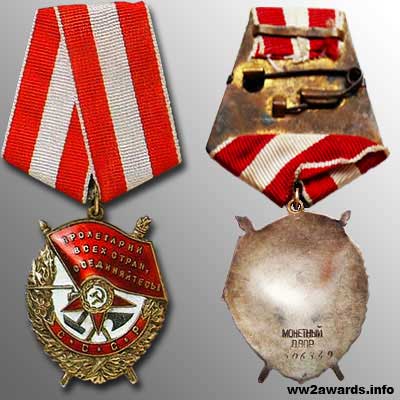
History Order of Red Banner
In September 1918, at a meeting of the Revolutionary Military Council of the RSFSR, an idea proposed, to create the first award in the history of the young state, to reward individuals for outstanding services. Within two weeks, the Draft Decree on Insignia drafted; later such decrees began to called statutes. This decree established the Order of the Red Banner, work on the image of which began a number of artists. From the presented sketches, the work of Vladimir Denisov selected.
The Order of the Red Banner is a wreath of oak leaves with a ribbon bearing the inscription «РСФСР» (RSFSR). In the center on a white background, a plow, a torch, a hammer and a bayonet, covered with a five-pointed star, in the center of which is a sickle and a hammer, framed by a laurel wreath. At the top is a red banner with the inscription «ПРОЛЕТАРИИ ВСЕХ СТРАН СОЕДИНЯЙТЕСЬ» (PROLETARIES OF ALL COUNTRIES UNITE). Although the order looks like a heap of symbols, but at that time, according to the leadership of the country, the Order of the Red Banner most fully reflected the ideas and aspirations of the young republic. The elements depicted on the order represented the following symbols: the red star and the red banner were official symbols of the state, bayonet, hammer and plow, symbolized the unity of the military, workers and peasants, the burning torch meant the memory of the heroes who died for our bright future.
The first awards were made of brass by firms Brothers Bronzei, but these copies did not suit the commissar of Leon Trotsky, the manufacture of the Order of the Red Banner transferred to the Petrograd Mint, where new orders were already made of gilded silver.
In 1920, the question arose of re-awarding; the order’s charter did not envisage this, but the Order of the Red Banner was the only military order, and the war continued in the country. Leon Trotsky decided to replace the Order with a similar one, on which a numeral appeared on the bottom, indicating how many times this award awarded.
In the same year, an award established for the top command of the Red Army; they awarded an honorary revolutionary weapon, a checker and a pistol with waybills of the Order of the Red Banner. In the decree of the award, it written «The honorary revolutionary weapon, as an exceptional award, is awarded for special combat distinctions shown by the top commanders in the army in force». The checker with the Order of the Red Banner of the RSFSR was awarded only 21 times, among the owners are such well-known figures of the revolution as Frunze, Budyonny, Voroshilov, Kotovsky, Tukhachevsky, Tymoshenko and others. The Mauser C96 pistol with the Order of the Red Banner handed in only twice; its owners in January 1921 were Kamenev SS. and Budenny SM.
In 1922, at the time of the organization of the USSR, most of the Union republics had their version of the Order of the Red Banner, the awards decided to lead to a single model. At the newly announced competition, the commission received 683 sketches from 393 authors, but all of them were inferior to the old order. As a result, a variant of a simple replacement of letters, the Order of the Red Banner of the RSFSR was proposed, an inscription replaced with «СССР» (USSR). All the orders of the Soviet republics that awarded in 1918-1924 equated with the all-Union order.
The order is made of silver. Silver content in the order - 22,719 ± 1,389 g (on September 18, 1975). The total weight of the Order is 25.134 ± 1.8 g
Until the establishment of the Order of Lenin in 1930, the Order of the Red Banner remained the highest award of the Soviet Union.
There was also an attempt to renew the awarding of premium weapons with the Order of the Red Banner, now the USSR. December 12, 1924, issued a relevant resolution, but in fact, this award awarded only once. In 1929, the saber with the Order handed to the commander of the Transbaikal group of troop’s corps Vostretsov.
At the beginning of the Great Patriotic War, the question raised about creating a special award - the Order of the Red Banner with swords, but this proposal rejected by Comrade Stalin. Instead, the commanders orders of Suvorov, Kutuzov and Alexander Nevsky were established.
List of recipients Order of Red Banner
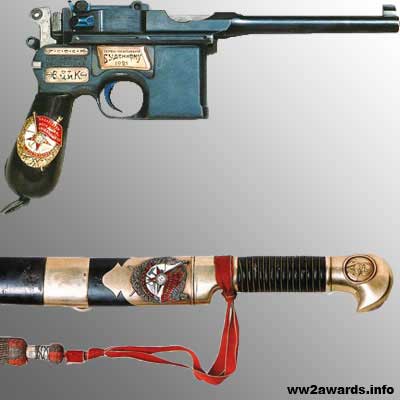
The first awarded Vasily Konstantinovich Blyukher in 1918, for the unification under his command of the scattered partisan, Red Army detachments, and a campaign of 1500 miles across the Urals. Later Blyukher awarded three times the Order of the Red Banner of the RSFSR, and once the Order of the Red Banner the USSR.
In 1919-30, many military units were awarded with the Order: 5th Army, Separate Caucasian Army; 7th, 15th and 24th Rifle Divisions; 3rd, 6th and 10th Cavalry Divisions; the Baltic Fleet and the cruiser Aurora, Armored train number 8, the Military Academy of the Red Army, the city of Petrograd, as well as a number of other formations, units and subunits.
In total, on January 1, 1933, produced 16317 awards one order, 378 two, 60 three and 7 four.
One of the first awarded the Order of the Red Banner of the USSR was a group of Chekists: Menzhinsky, Fedorov, Syroezhkin, Demidenko, Puzitsky, Pilyar, for carrying out the OGPU task to fight a group of counterrevolutionaries led by B. Savinkov.
The next Knights of the Order were again not military men. In 1925, all participants in the Moscow-Peking flight, under the command of Academician Schmidt, awarded.
In the next five years, the order given extremely rarely, since the award was still military, and the Soviet Union did not officially wage war. Only in 1929, the rewarding of the order resumed, several dozen people awarded for battles on the Sino-East Railway.
Before the Second World War, the mass awarding of the Order of the Red Banner were made for participation in the war in Spain, for fights at Lake Khasan, and on the Khalkhin-Gol River, for a total of 2575 awards.
After the outbreak of the Second World War, the awarding of the Order became massive. For military operations against Finland, completely military units were awarded, among them the 7th Infantry Division of the Kiev Special Military District, the 142nd Infantry Division, the 137th Howitzer and the 320th Artillery Regiment.
The younger staff of the Red Army rarely awarded the Order of the Red Banner of Battle. Although there were exceptions to these rules. Thus, the young partisan from Kerch, Volodya Dubinin, awarded the Order of the Red Banner at the age of 13 (posthumously), 14-year-old sailor Igor Pakhomov, was a double Knight of the Order of the Red Banner. Pioneer Kostya Kravchuk from Kiev, who saved the regimental banner of the 968th and 970th regiments, awarded the Order at the age of 12 years.
Many foreign citizens became Knights of the Order of the Red Banner. So the order awarded to the commander of the Normandie-Niemen air regiment Pierre Pouyad and the pilot of the same regiment Marquis Rolland de la Poip.
The same order of the Red Banner awarded to entire foreign units. The 1st Romanian Volunteer Infantry Division named after Tudor Vladimirescu, who fought against the fascists shoulder to shoulder with the Red Army in the autumn of 1944, received this award for the heroism shown in the Debrecen operation. As a result, the division was renamed the Red Banner of Debrecen.
Over the years of the war, more than 238,000 awards held, among them more than 3,270 awards of formations, units, departments and enterprises.
The Order of the Red Banner could be awarded even to such huge military formations as the district. So the Kiev military district by the Decree of the Presidium of the USSR Supreme Armed Forces on February 22, 1963 was awarded the Order of the Red Banner.
Among the enterprises awarded the Order of the Red Banner of Labor, it is worth noting the Leningrad Association «Kirov Plant», Gorky Automobile Plant, Ural Heavy Machine Building Plant named after. S.Ordzhonikidze. In addition, even such a purely peaceful institution as the Moscow Central Studio of Documentary Films (TSSDF), in 1944 awarded this honorary military order.
The decree of June 4, 1944, introduced the order of awarding the Order of the Red Banner for 20 years, and again - for 30 years of impeccable service. For 14 years of the decree, the Order of the Red Banner was given about 300,000 times for long service and only a few hundred servicemen for military distinctions (mainly for the war in Korea and the punitive operation in Hungary). The decree abolished on February 11, 1958, to raise the prestige of the award.
After 1958, the Order of the Red Banner awarded to the participants of the war in Vietnam (1965-1975), Egypt (1973), Afghanistan (1979-89).
In total from 1924 to 1991 the Order of the Red Banner was made more than 581,300 awards. Among them, there are more than 350 five-time cavaliers, 41 six fold, 15 sevenfold and one eightfold.
The only person who awarded the Order of the Red Banner eight times was Marshal of Aviation, Hero of the Soviet Union Ivan Ivanovich Pstygo. However, the eighth order handed to him did not have a cartouche with the award number. Thus, the Order of the Red Banner with the number 8 on the cartouche never existed.
Order of the Red Banner in the award system of the USSR
Prices for Order of the Red Banner
To date, prices for the Order of the Red Banner start from:
1918-30 Type 0 «RSFSR» ≈15000 pcs. - 3500 $
1933-41 Type 1 «Mirror Reverse» ≈20000 pcs. - 2000 $
1941-43 Type 2 «Smooth reverse» ≈60000 pcs. - 750 $
1943 Type 3 «Dovetail» ≈3500 pcs. - 350 $
1943-50 Type 4 «Round» ≈262500 pcs. - 120 $
1951-91 Type 5 «Elliptical» ≈212000 pcs. - 120 $
Second award, of the screw ≈4500 pcs. - 600 $
Second award, ribbon bar ≈35000 pcs. - 900 $
Third award, of the screw ≈600 pcs. - 12000 $
Third award, ribbon bar ≈9000 pcs. - 3400 $
Fourth Award of the screw ≈100 pcs. - 50000 $
Fourth Award ribbon bar ≈3000 pcs. - 7000 $
The price has been updated on: 12.09.2025 yr.
Varieties of the Order of the Red Banner
Type 0 «RSFSR»
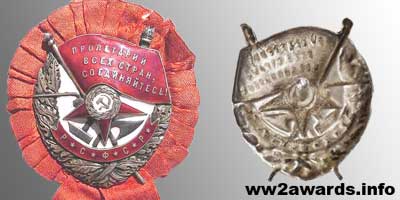
Numbers: 623-21216
Dimensions: height - 43 mm, width – 39 mm.
Order «Red Banner» of the RSFSR awarded from September 30, 1918, until 1929-1930. Despite the fact that in 1924 the All-Union Order was established, the awarding of the Order of the Red Banner of the USSR began only in 1930. This is due to the large number of signs of the Republican Order, which remained untapped in the vaults of the mint.
Sign of the Order of the Red Banner of the RSFSR is made of four elements. The first, directly the sign itself, with the threaded screw soldered on the reverse. The second, a cloth rosette of red color, with a hole for a threaded screw. The third, round plate, for better attaching the sign to clothing, and the fourth round nut with a diameter of 14-16 mm, screwed onto the screw.
The reverse of the sign is embossed, practically mirroring the obverse relief. The brand of the manufacturer on the sign is missing. The award number is engraved by hand, with a engraver.
Type 1 «Mirror Reverse»
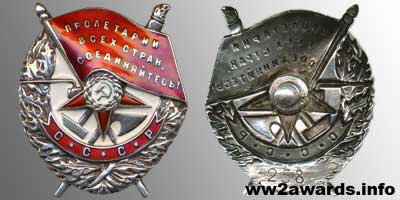
Numbers: 15-19897
Dimensions: height – 39-40 mm, width – 36 mm.
All-Union Order distinguished by the inscription «СССР» (USSR), and in addition, it had slightly smaller dimensions 39*36 mm, against 43*39 from the Republican order.
The reverse of the sign is embossed, with very good detail, mirroring the obverse of the order. On the reverse, a silver threaded screw, diameter 4.5 mm, with a washer with a cut in the base, soldered in the center. The clamping nut has increased in diameter to 28 mm and has acquired two protrusions to facilitate its tightening.
The mint stamp is still missing. The order number on early signs (numbers 15-200) applied along the upper left edge of the reverse, on later ones on a smooth platform at the lower edge of the reverse.
According to the book of arrival and expenditure of the orders of the Red Banner, during the years 1932-33, only 20006 orders of the first type produced.
Type 2 «Smooth reverse»
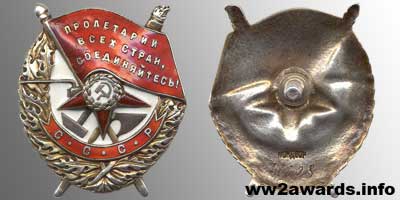
Numbers: 20027- 79807
Dimensions: height – 40-41 mm, width – 36-37 mm.
The second version of the order appeared presumable in 1941. Its main difference was the almost smooth reverse, which now had a barely noticeable shape of the obverse. In the center of the reverse, the screw still soldered, the washer at the base of which lost the cut. The clamping nut became even larger and now had a diameter of 33 mm.
In addition, on the reverse, there appeared the stamp «МОНДВОР» (MINT) of the number 20027-21154 or «МОНЕТНЫЙ ДВОР» (COIN YARD) of the number 21211-79807. The stamp «МОНДВОР» made engraver by hand and is located in the upper part of the order on early versions of the award. In later versions, the stamp «МОНДВОР» and all the stamps «МОНЕТНЫЙ ДВОР» (COIN YARD) are located in the lower part of the order, and are made by stamping. The order number was carried out by engraver and is located at the bottom of the award.
Type 3 «Dovetail»

Numbers: 77483- 84243
Dimensions: height – 41,5 mm, width – 37 mm.
According to the Decree of June 19, 1943, orders of round and oval shape, including the Order of the Red Banner, to worn on the left side of the chest, on a pentagonal block. Accordingly, the sign of a new type lost the screw on the reverse and purchased the ring in the upper part, for attaching to the pentagonal block. In addition, it allowed instead of a sign, to wear the ribbon of the order on the award ribbon bar. The order ribbon is red, with one white broad band in the center, and two narrow white stripes along the edges.
By the time the Decree was issued, a significant number of blanks of orders of the previous, second type remained on the order that was making the order of Krasnokamsky. Given the plight of the country that is at war with the fascist invaders, it decided to redo the existing signs, for wearing on the block, with minimal costs. The alteration done by removing a small segment from the reverse, and replacing it with a similar segment with a ring for fastening to the block. The segment with the ring attached to the reverse by soldering. Among the collectors, this version of the order called «Dovetail» or «Swallow».
On the reverse side, apart from the clearly visible soldered segment, the stamp «МОНЕТНЫЙ ДВОР» (COIN YARD), inflicted by two separate stamps «МОНЕТНЫЙ» and «ДВОР», so the distance between words may be slightly different. In addition, the word «МОНЕТНЫЙ» is rounded in an arc upward. The order number carried out by engraver and placed below the stamp.
Type 4 «Round»
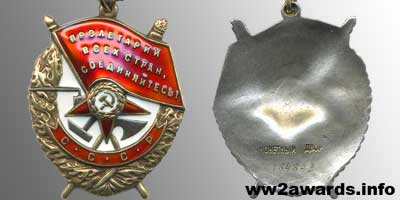
Numbers: 84259 – 359322
Dimensions: height – 41,5 mm, width – 38 mm.
After the exhaustion of the reserves, on the Krasnokamsk Mint began issuing new orders, wear them on the block. The fourth type of the Order of the Red Banner made from 1943 to 1951 on the Krasnokamsky and Moscow Mints.
The obverse of the award has not changed. The reverse has a noticeable relief, with folds and irregularities in the early versions, or a recess in the center of the reverse in more recent versions. The stamp «МОНЕТНЫЙ ДВОР» (COIN YARD) is located in the lower part of the order, in one line on the signs made in 1943-1949, or in two lines, on the last marks made by the Moscow Mint in 1950-1951. The order number, as before, is located below the hallmark and made with engraver.
Type 5 «Elliptical»

Numbers: 355173 – 566746
Dimensions: height without ring – 41,5 mm, width – 36,3 mm.
In November 1951, a new Technical Condition for the manufacture of the Red Banner Orders issued. They set the following dimensions of the sign: height without ring - 41.5 mm, taking into account the ring - 46 mm, width - 36.3 mm. As a result, the order became already, approximately 1.5 mm, compared with the previous type.
This type of sign of the Order of the Red Banner existed from 1951, until the collapse of the USSR. His production handled by the Moscow and Leningrad Mints. On the reverse of the sign, as before, there is a depressed relief recess. The stamp «МОНЕТНЫЙ ДВОР» stamped in two lines, at the bottom of the reverse. The order number made with engraver and is located below the stamps.
Order of re-awarding

According to the statute of the order, with the re-awarding of the Order of the Red Banner, the order awarded, with a white enamel shield in the lower part of the order, indicating the number of awards.
In all other respects, the design of the re-awarding marks, almost completely repeats the design of the signs of the first award, the corresponding years. For the screw version, both the RSFSR and the USSR, there are signs with the number 2, 3 and 4. For the hanging version, there are signs with the number from 2 to 7. Although there is, one person awarded the order eight times, the sign of the Order of the Red Banner with the number 8 on the shield never made.
Statute of the Order of Red Banner
The award established on 19.09.1918 as the Order of the Red Banner of the RSFSR, and after the formation of the USSR, by the decree of 1.08.1924, the Red Banner Order unified for all republics, amendments and additions to the statute of the award made: 11.01.1932; 06.19.1943; 16.12.1947; 03.28.1980.
The Order of the Red Banner established for rewarding for the special bravery, selflessness and courage shown in the defense of the socialist Fatherland.
The Order of the Red Banner awarded to:
- Servicemen of the Soviet Army, the Navy, border and internal troops, officers of the State Security Committee of the USSR and other citizens of the USSR;
- military units, warships, formations and associations.
Order of the Red Banner may be awarded to persons who are not citizens of the USSR.
Awarding the Order of the Red Banner:
- for particularly significant feats committed in a combat situation with a clear danger to life;
- for outstanding leadership of the military operations of military units, formations, associations, and displayed special courage and courage;
- for the special courage and bravery shown in the performance of a special task;
- for the special courage and bravery shown in ensuring national security of the country, the inviolability of the state border of the USSR in conditions that involve a risk to life;
- for successful military operations of military units, warships, formations and associations that, despite the enemy’s stubborn resistance end losses or other unfavorable conditions, defeated the enemy or caused him a major defeat or contributed to the success of our troops in carrying out a major combat operation.
In exceptional cases, the awarding of the Order of the Red Banner can also be made for particularly significant achievements in maintaining high combat readiness of troops, as well as for exploits committed while performing military duty with a clear danger to life.
When re-awarded the Order of the Red Banner, the recipient is awarded an order with the number «2», and at subsequent awards - with the corresponding figures.
Rewarding is based on the submission of the USSR Ministry of Defense, USSR Ministry of Internal Affairs, and the KGB of the USSR, respectively.
Military units, warships, formations and associations awarded with the Order of the Red Banner are called «Red Banners».
Order of the Red Banner is worn on the left side of the chest and in the presence of other orders of the USSR is located after the Order of the October Revolution.
Updated: 2025-09-12 03:02:20